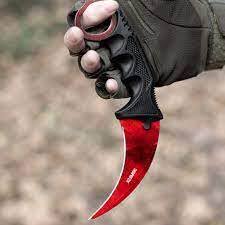Self-defense weaponry, the Karambit knife stands out as a formidable and versatile tool. Originating in Southeast Asia, this curved blade, often with a hawkbill design, has proven its effectiveness in close-quarters combat situations. While its unique design may seem intimidating, the Karambit can be mastered with proper training and responsible use.
As Handmade knives, we’re dedicated to providing you with valuable insights into practical and effective self-defense techniques. Whether you’re a seasoned martial artist or a beginner, this article will help you unlock the full potential of the karambit for personal protection.
Gripping Techniques
The Karambit’s anatomy consists of three key components: the blade, the handle, and the ring. The blade typically curved and either serrated or plain, is the heart of the Karambit’s effectiveness. The handle, designed for comfort and control, can be made from various materials, including wood, plastic, or metal. The ring, located at the end of the handle, secures the Karambit to the hand, ensuring a firm grip during combat.
When it comes to gripping the Karambit, two primary techniques prevail the forward grip and the Reverse grip. In the forward grip, the blade faces forward, providing a natural slashing motion. The reverse grip, with the blade facing backward, allows for more precise control and trapping techniques. The choice of grip depends on the situation and the user’s preference.

Basic Striking Patterns: the Karambit’s Power
The Karambit’s unique patterns make it an effective tool for self-defense. Its horizontal slashes are ideal for close-quarters combat, while vertical slashes can be used to take down larger opponents. Proper body mechanics and footwork are crucial for generating power and accuracy when striking with the Karambit. Maintaining a slightly bent stance and maximizing impact by targeting major arteries and nerves is crucial.
Defensive Techniques
While the Karambit knives are in offense, their defensive capabilities are equally valuable. Parrying and blocking are the cornerstones of Karambit’s defense. Parrying involves deflecting an incoming attack while blocking directly stops the attack.
Situational awareness and maintaining a safe distance from the attacker are essential for effective Karambit defense. The Karambit can be used to counter various types of attacks, from knife assaults to grabs and punches.
Advanced Karambit Techniques:

For those interested in mastering the Karambit, advanced techniques including trapping, disarming, and throws can expand its repertoire. Trapping techniques control an attacker’s arm or hand, while disarms aim to take away their weapon. Throws, though requiring more practice, can incapacitate an attacker by bringing them to the ground. Mastering advanced Karambit techniques demands proper training and consistent practice. These techniques, when used improperly, can be dangerous.
Here are some of the advanced Karambit techniques you can learn:
- Trapping: Trapping techniques are used to control an attacker’s arm or hand. This can be done by using the Karambit to pin the attacker’s arm against their body or by using the Karambit to trap the attacker’s hand between the Karambit and your body.
- Disarms: Disarms are used to take away an attacker’s weapon. This can be done by using the Karambit to knock the attacker’s weapon out of their hand or by using the Karambit to pry the attacker’s hand off of their weapon.
- Throws: Throws are used to incapacitate an attacker by bringing them to the ground. This can be done by using the Karambit to hook the attacker’s clothing or by using the Karambit to sweep the attacker’s legs out from under them.
Mastering advanced Karambit techniques takes time and dedication. It is important to find a qualified instructor who can teach you the proper techniques and to practice regularly. With hard work and perseverance, you can master the art of close-quarters combat with the Karambit.

Responsible Karambit Ownership and Usage
The Karambit is a powerful and versatile tool that can be used for a variety of purposes, including self-defense, hunting, and utility. However, because it is a weapon. It is important to use it responsibly. Here are some tips for responsible Karambit ownership and usage
- Know the laws in your area. In many jurisdictions, there are restrictions on the ownership and carrying of knives. Make sure you are familiar with the laws in your area before you buy or carry a Karambit.
- Store the Karambit safely. When not in use, store the Karambit in a safe place where it cannot be accessed by unauthorized persons, such as children or criminals. A gun safe or a locked cabinet is a good option.
- Get training from a qualified instructor. Learning how to use the Karambit safely and effectively is essential for responsible ownership. Taking a course from a qualified instructor can teach you the proper techniques for using the Karambit and can help you avoid accidents.
- Practice regularly. The more you practice with the Karambit, the better you will become at using it safely and effectively. Make sure to practice on a regular basis to keep your skills sharp.
Conclusion
The Karambit, when mastered responsibly, can be a powerful tool for self-defense. Proper training, emphasizing techniques, safety, and legal awareness, is paramount. Seek guidance from qualified instructors to unlock Karambit’s potential and empower yourself with the confidence to defend yourself effectively.
